Grays Peak
February 22-23, 2009 - from Stevens Gulch - Winter
February 22nd - Approach and camp
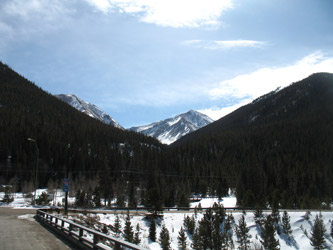 It was mid February and the high country forecast called for a weather window, a gorgeous Sunday with temperatures on the Front Range up to the 60 degree mark. G was just 6 weeks out from his ACL rebuild so I asked Bob if he was ready to get his winter ridge card punched. We set our sights on Kelso Ridge, the class 3/4 route on Torreys that I had soloed late April of 2002. Bob and I had previously climbed the west ridge of Pacific Peak but that was summer. this was going to be one of those dream weekends when the weather promised little wind and warm enough temps for a trip up this spectacular route. Yea right . . . It was mid February and the high country forecast called for a weather window, a gorgeous Sunday with temperatures on the Front Range up to the 60 degree mark. G was just 6 weeks out from his ACL rebuild so I asked Bob if he was ready to get his winter ridge card punched. We set our sights on Kelso Ridge, the class 3/4 route on Torreys that I had soloed late April of 2002. Bob and I had previously climbed the west ridge of Pacific Peak but that was summer. this was going to be one of those dream weekends when the weather promised little wind and warm enough temps for a trip up this spectacular route. Yea right . . .
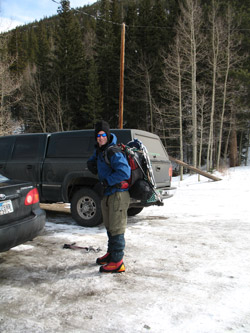 We parked in the lot just off the Bakerville exit of I-70, along with about a dozen other cars. The temperature was a balmy 50 degrees, yes 50 on February 22 at 1:30 in the afternoon. We'd heard the road to the summer trail head was well packed by snow machines but figured snow shoes would be needed higher up. I'd never hoofed it to the summer trail head but I knew the road walk would be about 3 miles and I hoped it would not take more than two or two and a half hours. Our loads were a bit heavier than I like, but I'm not getting any younger and I suspect that age has something to do with the perception of weight in a pack. I remarked to Bob that this would be a 3 mile approach with no seriously heavy gear, as compared to the route G, Ed and I took to the Shurman Camp on Rainier this past summer. We parked in the lot just off the Bakerville exit of I-70, along with about a dozen other cars. The temperature was a balmy 50 degrees, yes 50 on February 22 at 1:30 in the afternoon. We'd heard the road to the summer trail head was well packed by snow machines but figured snow shoes would be needed higher up. I'd never hoofed it to the summer trail head but I knew the road walk would be about 3 miles and I hoped it would not take more than two or two and a half hours. Our loads were a bit heavier than I like, but I'm not getting any younger and I suspect that age has something to do with the perception of weight in a pack. I remarked to Bob that this would be a 3 mile approach with no seriously heavy gear, as compared to the route G, Ed and I took to the Shurman Camp on Rainier this past summer.
The day was just remarkable and I knew we were going to score a plum winter climb, but Pachamama had other plans in store for us . . . plans she would not make known until the next morning. We hefted our packs and headed up the road. 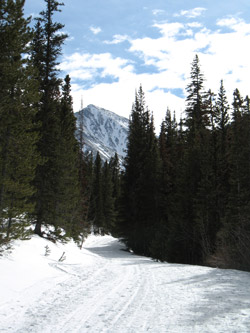 I knew the path, to some extent, from previous drives and I would rather have driven it. We walked steadily once we got a rhythm going but I'd swear that must have taken about the first 1/3 of the route. I took a slug of water and a Goo at the road junction and then, with a bit more vigor, we made our way up the last mile and half to the summer trail head. On the way, we could see Kelso ridge ahead and it appeared quite "do-able" and both of us were clearly psyched for the next day's climb. I knew the path, to some extent, from previous drives and I would rather have driven it. We walked steadily once we got a rhythm going but I'd swear that must have taken about the first 1/3 of the route. I took a slug of water and a Goo at the road junction and then, with a bit more vigor, we made our way up the last mile and half to the summer trail head. On the way, we could see Kelso ridge ahead and it appeared quite "do-able" and both of us were clearly psyched for the next day's climb.
We got to the summer trail head which for the purpose of winter camping, was the last real chance to camp 'fairly low" in the trees. Some folks go higher but this was good enough for me as I planned to camp the night in a Black Diamond megamid tent. If you are unfamiliar with the model, think about one pound of sil-nylon, a footprint of 81 square feet and almost 5 feet of head space in the center. Did I mention that there is no floor? For those who have camped in a megamid in the winter, I would guess you fall into either the "love it" 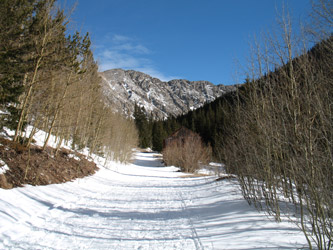 or the "leave it" camp. I've really come to prefer it as my snow camping choice, not for a glacier camp, but for a Colorado winter camp in the trees where I want to be comfortable and sit up. I'm 48 and I really want to sit up in the tent, have my gear in the tent within easy reach, and cook right there instead of outside or in a vestibule. The mid has a good vent and why not enjoy 65 degrees of comfort while you eat and melt snow. I wasn't a Marine, I can enjoy some comforts when camping before a climb. or the "leave it" camp. I've really come to prefer it as my snow camping choice, not for a glacier camp, but for a Colorado winter camp in the trees where I want to be comfortable and sit up. I'm 48 and I really want to sit up in the tent, have my gear in the tent within easy reach, and cook right there instead of outside or in a vestibule. The mid has a good vent and why not enjoy 65 degrees of comfort while you eat and melt snow. I wasn't a Marine, I can enjoy some comforts when camping before a climb.
The key to using the 'mid is to stamp a good 12 x 12 foot snow pad and then set the 'mid up on the hardening surface. We both set to snow shoeing a square for the tent and within 20 minutes we left the snow pad to harden up while we harvested some foot long sticks to use as tent stakes. I laid out the mid and showed Bob how to bury a stick in the snow as a dead man and 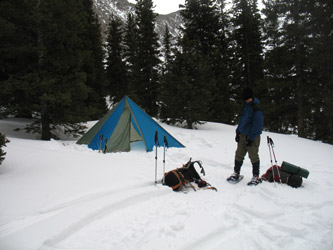 with a bit of stomping, set that "stake" well enough that he would not be able to pull it out without the aid of an ice axe. One the tent was up, we stashed the gear inside and I concocted my air mattress/space blanket pad arrangement that works well for me every time. First the inflatable pad goes down, then the space blanket goes over top and then the down bag. I can roll around and off the pad and I'm still dry the next morning. with a bit of stomping, set that "stake" well enough that he would not be able to pull it out without the aid of an ice axe. One the tent was up, we stashed the gear inside and I concocted my air mattress/space blanket pad arrangement that works well for me every time. First the inflatable pad goes down, then the space blanket goes over top and then the down bag. I can roll around and off the pad and I'm still dry the next morning.
For dinner, I made a hot soup of ramen noodles with some broccoli thrown in for variety. I'd made a batch of beef jerky and after those items were eaten, we graduated to chicken wraps with cheese and lettuce. The wonders of a George Foreman grill and the zip lock bag will never cease to amaze me. Dinner was over and Bob got a lesson in melting snow for water, not that it is hard, just that I showed him the old bring a garbage bag along, fill it with snow chunks and then just melt bag snow . . . as in why go back outside when it is warm inside. Darkness came on soon enough and I set the alarm for a 4 am wake up. I figured we'd melt a bit of snow, eat some muesli and yogurt and be out the door no later than 5 am, bound for Kelso Ridge.
February 23rd - Climb
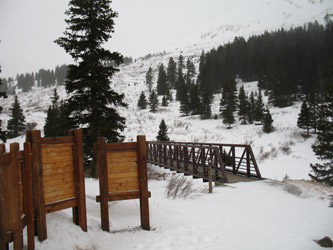 There was no wind during our approach but as the night wore on, there were those gusts that you hear coming through the trees, getting louder and louder, until they reach your tent. The 'mid would shudder and the condensation from our cooking effort and our night's breathing would shake loose, dusting our exposed faces, reminding us that we were camping in the winter. I'd gotten the bag pretty tight around the face and seemed to know just when to turn my face downward to pretty much avoid the shivers that a good dusting would bring. The alarm put that game to an end and as I woke, I heard the steady "tic-tic-tick-tic" sound that means ice pellets are falling on the tent. There was no wind during our approach but as the night wore on, there were those gusts that you hear coming through the trees, getting louder and louder, until they reach your tent. The 'mid would shudder and the condensation from our cooking effort and our night's breathing would shake loose, dusting our exposed faces, reminding us that we were camping in the winter. I'd gotten the bag pretty tight around the face and seemed to know just when to turn my face downward to pretty much avoid the shivers that a good dusting would bring. The alarm put that game to an end and as I woke, I heard the steady "tic-tic-tick-tic" sound that means ice pellets are falling on the tent.
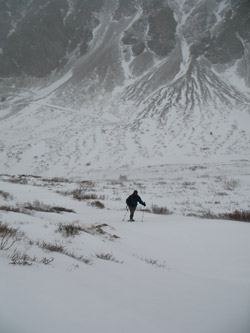 I got up just enough to find my headlamp and to open the door. You got it, winter had come back earlier than the majority of forecasts said it would. Now,I will admit I did see one forecast that called for 2 to 4 inches of snow but all of the others were holding short and just calling for clouds. I like "happy ending" forecasts so I was camping that night in the 'mid, rather than thinking how brilliant I was for getting an alpine start on Sunday and getting a day climb in during the weather window. I saw the ice in the headlamp beam and Bob asked what my thoughts were. My response was that the best move was to get two more hours of sleep until we can see just how low the ceiling is and if there is hope for a sun burn off of the morning scud. I woke at 6 am and it was still snowing . . . by 7 am, we had concluded that we might as well get up and make something of the day. I got up just enough to find my headlamp and to open the door. You got it, winter had come back earlier than the majority of forecasts said it would. Now,I will admit I did see one forecast that called for 2 to 4 inches of snow but all of the others were holding short and just calling for clouds. I like "happy ending" forecasts so I was camping that night in the 'mid, rather than thinking how brilliant I was for getting an alpine start on Sunday and getting a day climb in during the weather window. I saw the ice in the headlamp beam and Bob asked what my thoughts were. My response was that the best move was to get two more hours of sleep until we can see just how low the ceiling is and if there is hope for a sun burn off of the morning scud. I woke at 6 am and it was still snowing . . . by 7 am, we had concluded that we might as well get up and make something of the day.
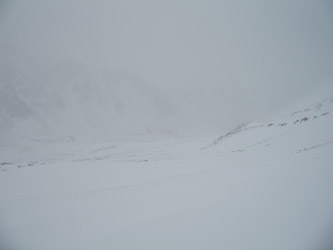 Climbing Kelso Ridge in a snow storm with clouds on the deck was not on my list of potential activities but I did entertain the thought of hiking a mile or so up the Gulch, perhaps to the start of the ridge to get some exercise greater than just breaking camp and running for the car. We melted a quart of water for Bob and re-heated my quart so I could at least start off with some warm Cytomax. We packed for a light day trip, but not forgetting the extra layers and my now standard "oh shit kit" including the "ten essentials" and a light bivy sack. The snow shoes went on right at the tent and soon we were clomping across the timber deck of the bridge over the creek and onto the trail leading up Stevens gulch. Climbing Kelso Ridge in a snow storm with clouds on the deck was not on my list of potential activities but I did entertain the thought of hiking a mile or so up the Gulch, perhaps to the start of the ridge to get some exercise greater than just breaking camp and running for the car. We melted a quart of water for Bob and re-heated my quart so I could at least start off with some warm Cytomax. We packed for a light day trip, but not forgetting the extra layers and my now standard "oh shit kit" including the "ten essentials" and a light bivy sack. The snow shoes went on right at the tent and soon we were clomping across the timber deck of the bridge over the creek and onto the trail leading up Stevens gulch.
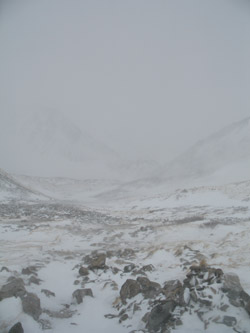 I'd been up the trail three times before so I knew where I was going snow or no snow. The route was clearly tracked from the good weather weekend and there was not quite enough snow to blot out the trail cut through the willows. We hit the right turns and traversed along the base of Kelso Mountain, the orb of the sun showing through once or twice but that was it for the day. The snow fell steadily and the wind would come in gusts of up to about 30 mph . . . but the air was still warm and neither of us was chilled in body or limb. We were doing fine but did stop to look at and discuss the deteriorating visibility. I think Stevens Gulch is kind of hard to get totally screwed up in because if you go downhill to the creek and follow it, you have to hit the foot bridge and our camp. I'd been up the trail three times before so I knew where I was going snow or no snow. The route was clearly tracked from the good weather weekend and there was not quite enough snow to blot out the trail cut through the willows. We hit the right turns and traversed along the base of Kelso Mountain, the orb of the sun showing through once or twice but that was it for the day. The snow fell steadily and the wind would come in gusts of up to about 30 mph . . . but the air was still warm and neither of us was chilled in body or limb. We were doing fine but did stop to look at and discuss the deteriorating visibility. I think Stevens Gulch is kind of hard to get totally screwed up in because if you go downhill to the creek and follow it, you have to hit the foot bridge and our camp.
We arrived at the rocky flats just short of the saddle that forms the start of Kelso Ridge and took off our snow shoes. The trail was blown free of snow and I had a hunch that between trail segments and wind hammered patches we could make 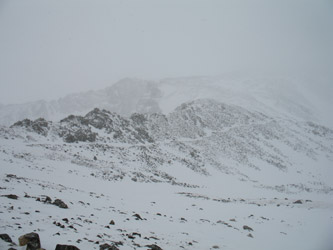 our way a bit further without the shoes . . . onto the outside of my pack they went. We passed the cut off to the Kelso saddle and then up and around the hummock that, until this point, blocks any real view of the lower reaches of Grays or Torreys. I note lower reaches as the ceiling was so low that we had never saw of anything further than about 14 to 1/3 of the way up any slope in the valley. I showed Bob the base of the Dead Dog couloir and noted that the Gray Peaks trail was the slash that we could see rising into the cloud and fog ahead of us. our way a bit further without the shoes . . . onto the outside of my pack they went. We passed the cut off to the Kelso saddle and then up and around the hummock that, until this point, blocks any real view of the lower reaches of Grays or Torreys. I note lower reaches as the ceiling was so low that we had never saw of anything further than about 14 to 1/3 of the way up any slope in the valley. I showed Bob the base of the Dead Dog couloir and noted that the Gray Peaks trail was the slash that we could see rising into the cloud and fog ahead of us.
I suggested that since the snow was not getting any lighter and the cloud base did not seem to plan to lift so that we could be bathed in sunlight, 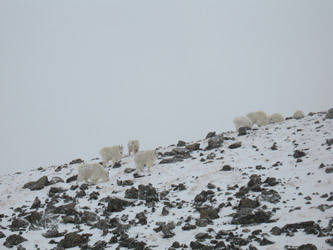 that we should continue to climb in the "sporting" conditions that Pachamama granted us this day. We climbed past a herd of perhaps 12 shaggy white mountain goats and continued along the sloping traverse that leads to the flat before the real start of the zig and zag of the summer trail up Grays Peak. My primary concern did not lie with the weather but with the risk of having to cross a snowfield to make the summit. I had read of an avi near miss the previous week on Torreys and I had no intent of setting foot on any of the high snowfields whose run outs terminate in the valley far below. that we should continue to climb in the "sporting" conditions that Pachamama granted us this day. We climbed past a herd of perhaps 12 shaggy white mountain goats and continued along the sloping traverse that leads to the flat before the real start of the zig and zag of the summer trail up Grays Peak. My primary concern did not lie with the weather but with the risk of having to cross a snowfield to make the summit. I had read of an avi near miss the previous week on Torreys and I had no intent of setting foot on any of the high snowfields whose run outs terminate in the valley far below.
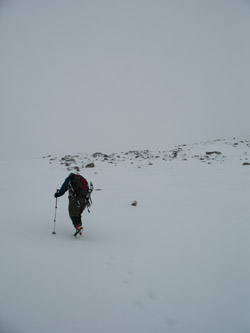 We took the trail to a point where it was a choice between crossing snow or turning upward for a direct route to the summit, the summit we knew was there but that we had not yet seen. I knew I was above the elevation of the connecting saddle, from prior climbs and from a brief glimpse we were granted for but two or three seconds. We turned for a direct route to the summit and about 20 minutes later, I spotted more cloud than rock and told Bob that we were a few minutes from topping out. The rocky climb yielded to fast winds and a snow filled wind shelter . . . the summit . . . all high enough to be seriously cold as compared to the 25 degree balmy day below. We could see little of our route up beyond the last 100 yards and there was no hope of seeing Torreys or any other surrounding peak. We were on the summit long enough for a shot of water, a Goo and a summit photo. We took the trail to a point where it was a choice between crossing snow or turning upward for a direct route to the summit, the summit we knew was there but that we had not yet seen. I knew I was above the elevation of the connecting saddle, from prior climbs and from a brief glimpse we were granted for but two or three seconds. We turned for a direct route to the summit and about 20 minutes later, I spotted more cloud than rock and told Bob that we were a few minutes from topping out. The rocky climb yielded to fast winds and a snow filled wind shelter . . . the summit . . . all high enough to be seriously cold as compared to the 25 degree balmy day below. We could see little of our route up beyond the last 100 yards and there was no hope of seeing Torreys or any other surrounding peak. We were on the summit long enough for a shot of water, a Goo and a summit photo.
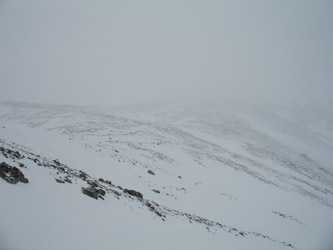 I took the lead down, knowing that our route had taken the edge of the big snowfield down to the big cairn marking the Torreys saddle traverse trail . . . a sure connection even in the lousy visibility. We hit the cairn and made good time down the snow and ice covered trail. We were hungry but I had little intent to stop before we were at the bare ground opposite the Kelso saddle. I wanted a low wind and warm temperature stop in lieu of some higher, more miserable venue. We ate a bit and then were off to the tent, stopping only to put the snowshoes back on about 1/4 mile beyond the lunch stop. We had started breaking through the crust here and there, and what the heck . . .why bust your hump if you don't have to. I took the lead down, knowing that our route had taken the edge of the big snowfield down to the big cairn marking the Torreys saddle traverse trail . . . a sure connection even in the lousy visibility. We hit the cairn and made good time down the snow and ice covered trail. We were hungry but I had little intent to stop before we were at the bare ground opposite the Kelso saddle. I wanted a low wind and warm temperature stop in lieu of some higher, more miserable venue. We ate a bit and then were off to the tent, stopping only to put the snowshoes back on about 1/4 mile beyond the lunch stop. We had started breaking through the crust here and there, and what the heck . . .why bust your hump if you don't have to.
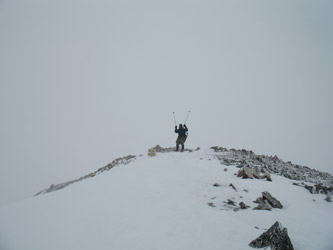 The tent had taken on a bit of snow but I only cared for minimizing the time needed to dig out the stakes, get the packs loaded and start moving back down the road to the car. Sparing our bodies due to the marvels of modern fabric, the wet snow had soaked everything else . . . pack, pack contents, 'mid . . . Game over, lets get to the car. We packed the gear, a bit more on the disorganized side and headed on down the road to the winter parking lot about 3 miles distant. We made good time, scored a winter 14'er summit and succeeded in making lemonade out of the lemons were were issued at 4 am that morning. The tent had taken on a bit of snow but I only cared for minimizing the time needed to dig out the stakes, get the packs loaded and start moving back down the road to the car. Sparing our bodies due to the marvels of modern fabric, the wet snow had soaked everything else . . . pack, pack contents, 'mid . . . Game over, lets get to the car. We packed the gear, a bit more on the disorganized side and headed on down the road to the winter parking lot about 3 miles distant. We made good time, scored a winter 14'er summit and succeeded in making lemonade out of the lemons were were issued at 4 am that morning.
|

 It was mid February and the high country forecast called for a weather window, a gorgeous Sunday with temperatures on the Front Range up to the 60 degree mark. G was just 6 weeks out from his ACL rebuild so I asked Bob if he was ready to get his winter ridge card punched. We set our sights on Kelso Ridge, the class 3/4 route on Torreys that I had soloed late April of 2002. Bob and I had previously climbed the west ridge of Pacific Peak but that was summer. this was going to be one of those dream weekends when the weather promised little wind and warm enough temps for a trip up this spectacular route. Yea right . . .
It was mid February and the high country forecast called for a weather window, a gorgeous Sunday with temperatures on the Front Range up to the 60 degree mark. G was just 6 weeks out from his ACL rebuild so I asked Bob if he was ready to get his winter ridge card punched. We set our sights on Kelso Ridge, the class 3/4 route on Torreys that I had soloed late April of 2002. Bob and I had previously climbed the west ridge of Pacific Peak but that was summer. this was going to be one of those dream weekends when the weather promised little wind and warm enough temps for a trip up this spectacular route. Yea right . . .  We parked in the lot just off the Bakerville exit of I-70, along with about a dozen other cars. The temperature was a balmy 50 degrees, yes 50 on February 22 at 1:30 in the afternoon. We'd heard the road to the summer trail head was well packed by snow machines but figured snow shoes would be needed higher up. I'd never hoofed it to the summer trail head but I knew the road walk would be about 3 miles and I hoped it would not take more than two or two and a half hours. Our loads were a bit heavier than I like, but I'm not getting any younger and I suspect that age has something to do with the perception of weight in a pack. I remarked to Bob that this would be a 3 mile approach with no seriously heavy gear, as compared to the route G, Ed and I took to the Shurman Camp on Rainier this past summer.
We parked in the lot just off the Bakerville exit of I-70, along with about a dozen other cars. The temperature was a balmy 50 degrees, yes 50 on February 22 at 1:30 in the afternoon. We'd heard the road to the summer trail head was well packed by snow machines but figured snow shoes would be needed higher up. I'd never hoofed it to the summer trail head but I knew the road walk would be about 3 miles and I hoped it would not take more than two or two and a half hours. Our loads were a bit heavier than I like, but I'm not getting any younger and I suspect that age has something to do with the perception of weight in a pack. I remarked to Bob that this would be a 3 mile approach with no seriously heavy gear, as compared to the route G, Ed and I took to the Shurman Camp on Rainier this past summer. I knew the path, to some extent, from previous drives and I would rather have driven it. We walked steadily once we got a rhythm going but I'd swear that must have taken about the first 1/3 of the route. I took a slug of water and a Goo at the road junction and then, with a bit more vigor, we made our way up the last mile and half to the summer trail head. On the way, we could see Kelso ridge ahead and it appeared quite "do-able" and both of us were clearly psyched for the next day's climb.
I knew the path, to some extent, from previous drives and I would rather have driven it. We walked steadily once we got a rhythm going but I'd swear that must have taken about the first 1/3 of the route. I took a slug of water and a Goo at the road junction and then, with a bit more vigor, we made our way up the last mile and half to the summer trail head. On the way, we could see Kelso ridge ahead and it appeared quite "do-able" and both of us were clearly psyched for the next day's climb.  or the "leave it" camp. I've really come to prefer it as my snow camping choice, not for a glacier camp, but for a Colorado winter camp in the trees where I want to be comfortable and sit up. I'm 48 and I really want to sit up in the tent, have my gear in the tent within easy reach, and cook right there instead of outside or in a vestibule. The mid has a good vent and why not enjoy 65 degrees of comfort while you eat and melt snow. I wasn't a Marine, I can enjoy some comforts when camping before a climb.
or the "leave it" camp. I've really come to prefer it as my snow camping choice, not for a glacier camp, but for a Colorado winter camp in the trees where I want to be comfortable and sit up. I'm 48 and I really want to sit up in the tent, have my gear in the tent within easy reach, and cook right there instead of outside or in a vestibule. The mid has a good vent and why not enjoy 65 degrees of comfort while you eat and melt snow. I wasn't a Marine, I can enjoy some comforts when camping before a climb. with a bit of stomping, set that "stake" well enough that he would not be able to pull it out without the aid of an ice axe. One the tent was up, we stashed the gear inside and I concocted my air mattress/space blanket pad arrangement that works well for me every time. First the inflatable pad goes down, then the space blanket goes over top and then the down bag. I can roll around and off the pad and I'm still dry the next morning.
with a bit of stomping, set that "stake" well enough that he would not be able to pull it out without the aid of an ice axe. One the tent was up, we stashed the gear inside and I concocted my air mattress/space blanket pad arrangement that works well for me every time. First the inflatable pad goes down, then the space blanket goes over top and then the down bag. I can roll around and off the pad and I'm still dry the next morning. There was no wind during our approach but as the night wore on, there were those gusts that you hear coming through the trees, getting louder and louder, until they reach your tent. The 'mid would shudder and the condensation from our cooking effort and our night's breathing would shake loose, dusting our exposed faces, reminding us that we were camping in the winter. I'd gotten the bag pretty tight around the face and seemed to know just when to turn my face downward to pretty much avoid the shivers that a good dusting would bring. The alarm put that game to an end and as I woke, I heard the steady "tic-tic-tick-tic" sound that means ice pellets are falling on the tent.
There was no wind during our approach but as the night wore on, there were those gusts that you hear coming through the trees, getting louder and louder, until they reach your tent. The 'mid would shudder and the condensation from our cooking effort and our night's breathing would shake loose, dusting our exposed faces, reminding us that we were camping in the winter. I'd gotten the bag pretty tight around the face and seemed to know just when to turn my face downward to pretty much avoid the shivers that a good dusting would bring. The alarm put that game to an end and as I woke, I heard the steady "tic-tic-tick-tic" sound that means ice pellets are falling on the tent. I got up just enough to find my headlamp and to open the door. You got it, winter had come back earlier than the majority of forecasts said it would. Now,I will admit I did see one forecast that called for 2 to 4 inches of snow but all of the others were holding short and just calling for clouds. I like "happy ending" forecasts so I was camping that night in the 'mid, rather than thinking how brilliant I was for getting an alpine start on Sunday and getting a day climb in during the weather window. I saw the ice in the headlamp beam and Bob asked what my thoughts were. My response was that the best move was to get two more hours of sleep until we can see just how low the ceiling is and if there is hope for a sun burn off of the morning scud. I woke at 6 am and it was still snowing . . . by 7 am, we had concluded that we might as well get up and make something of the day.
I got up just enough to find my headlamp and to open the door. You got it, winter had come back earlier than the majority of forecasts said it would. Now,I will admit I did see one forecast that called for 2 to 4 inches of snow but all of the others were holding short and just calling for clouds. I like "happy ending" forecasts so I was camping that night in the 'mid, rather than thinking how brilliant I was for getting an alpine start on Sunday and getting a day climb in during the weather window. I saw the ice in the headlamp beam and Bob asked what my thoughts were. My response was that the best move was to get two more hours of sleep until we can see just how low the ceiling is and if there is hope for a sun burn off of the morning scud. I woke at 6 am and it was still snowing . . . by 7 am, we had concluded that we might as well get up and make something of the day. Climbing Kelso Ridge in a snow storm with clouds on the deck was not on my list of potential activities but I did entertain the thought of hiking a mile or so up the Gulch, perhaps to the start of the ridge to get some exercise greater than just breaking camp and running for the car. We melted a quart of water for Bob and re-heated my quart so I could at least start off with some warm Cytomax. We packed for a light day trip, but not forgetting the extra layers and my now standard "oh shit kit" including the "ten essentials" and a light bivy sack. The snow shoes went on right at the tent and soon we were clomping across the timber deck of the bridge over the creek and onto the trail leading up Stevens gulch.
Climbing Kelso Ridge in a snow storm with clouds on the deck was not on my list of potential activities but I did entertain the thought of hiking a mile or so up the Gulch, perhaps to the start of the ridge to get some exercise greater than just breaking camp and running for the car. We melted a quart of water for Bob and re-heated my quart so I could at least start off with some warm Cytomax. We packed for a light day trip, but not forgetting the extra layers and my now standard "oh shit kit" including the "ten essentials" and a light bivy sack. The snow shoes went on right at the tent and soon we were clomping across the timber deck of the bridge over the creek and onto the trail leading up Stevens gulch. I'd been up the trail three times before so I knew where I was going snow or no snow. The route was clearly tracked from the good weather weekend and there was not quite enough snow to blot out the trail cut through the willows. We hit the right turns and traversed along the base of Kelso Mountain, the orb of the sun showing through once or twice but that was it for the day. The snow fell steadily and the wind would come in gusts of up to about 30 mph . . . but the air was still warm and neither of us was chilled in body or limb. We were doing fine but did stop to look at and discuss the deteriorating visibility. I think Stevens Gulch is kind of hard to get totally screwed up in because if you go downhill to the creek and follow it, you have to hit the foot bridge and our camp.
I'd been up the trail three times before so I knew where I was going snow or no snow. The route was clearly tracked from the good weather weekend and there was not quite enough snow to blot out the trail cut through the willows. We hit the right turns and traversed along the base of Kelso Mountain, the orb of the sun showing through once or twice but that was it for the day. The snow fell steadily and the wind would come in gusts of up to about 30 mph . . . but the air was still warm and neither of us was chilled in body or limb. We were doing fine but did stop to look at and discuss the deteriorating visibility. I think Stevens Gulch is kind of hard to get totally screwed up in because if you go downhill to the creek and follow it, you have to hit the foot bridge and our camp.  our way a bit further without the shoes . . . onto the outside of my pack they went. We passed the cut off to the Kelso saddle and then up and around the hummock that, until this point, blocks any real view of the lower reaches of Grays or Torreys. I note lower reaches as the ceiling was so low that we had never saw of anything further than about 14 to 1/3 of the way up any slope in the valley. I showed Bob the base of the Dead Dog couloir and noted that the Gray Peaks trail was the slash that we could see rising into the cloud and fog ahead of us.
our way a bit further without the shoes . . . onto the outside of my pack they went. We passed the cut off to the Kelso saddle and then up and around the hummock that, until this point, blocks any real view of the lower reaches of Grays or Torreys. I note lower reaches as the ceiling was so low that we had never saw of anything further than about 14 to 1/3 of the way up any slope in the valley. I showed Bob the base of the Dead Dog couloir and noted that the Gray Peaks trail was the slash that we could see rising into the cloud and fog ahead of us. that we should continue to climb in the "sporting" conditions that Pachamama granted us this day. We climbed past a herd of perhaps 12 shaggy white mountain goats and continued along the sloping traverse that leads to the flat before the real start of the zig and zag of the summer trail up Grays Peak. My primary concern did not lie with the weather but with the risk of having to cross a snowfield to make the summit. I had read of an avi near miss the previous week on Torreys and I had no intent of setting foot on any of the high snowfields whose run outs terminate in the valley far below.
that we should continue to climb in the "sporting" conditions that Pachamama granted us this day. We climbed past a herd of perhaps 12 shaggy white mountain goats and continued along the sloping traverse that leads to the flat before the real start of the zig and zag of the summer trail up Grays Peak. My primary concern did not lie with the weather but with the risk of having to cross a snowfield to make the summit. I had read of an avi near miss the previous week on Torreys and I had no intent of setting foot on any of the high snowfields whose run outs terminate in the valley far below. We took the trail to a point where it was a choice between crossing snow or turning upward for a direct route to the summit, the summit we knew was there but that we had not yet seen. I knew I was above the elevation of the connecting saddle, from prior climbs and from a brief glimpse we were granted for but two or three seconds. We turned for a direct route to the summit and about 20 minutes later, I spotted more cloud than rock and told Bob that we were a few minutes from topping out. The rocky climb yielded to fast winds and a snow filled wind shelter . . . the summit . . . all high enough to be seriously cold as compared to the 25 degree balmy day below. We could see little of our route up beyond the last 100 yards and there was no hope of seeing Torreys or any other surrounding peak. We were on the summit long enough for a shot of water, a Goo and a summit photo.
We took the trail to a point where it was a choice between crossing snow or turning upward for a direct route to the summit, the summit we knew was there but that we had not yet seen. I knew I was above the elevation of the connecting saddle, from prior climbs and from a brief glimpse we were granted for but two or three seconds. We turned for a direct route to the summit and about 20 minutes later, I spotted more cloud than rock and told Bob that we were a few minutes from topping out. The rocky climb yielded to fast winds and a snow filled wind shelter . . . the summit . . . all high enough to be seriously cold as compared to the 25 degree balmy day below. We could see little of our route up beyond the last 100 yards and there was no hope of seeing Torreys or any other surrounding peak. We were on the summit long enough for a shot of water, a Goo and a summit photo. I took the lead down, knowing that our route had taken the edge of the big snowfield down to the big cairn marking the Torreys saddle traverse trail . . . a sure connection even in the lousy visibility. We hit the cairn and made good time down the snow and ice covered trail. We were hungry but I had little intent to stop before we were at the bare ground opposite the Kelso saddle. I wanted a low wind and warm temperature stop in lieu of some higher, more miserable venue. We ate a bit and then were off to the tent, stopping only to put the snowshoes back on about 1/4 mile beyond the lunch stop. We had started breaking through the crust here and there, and what the heck . . .why bust your hump if you don't have to.
I took the lead down, knowing that our route had taken the edge of the big snowfield down to the big cairn marking the Torreys saddle traverse trail . . . a sure connection even in the lousy visibility. We hit the cairn and made good time down the snow and ice covered trail. We were hungry but I had little intent to stop before we were at the bare ground opposite the Kelso saddle. I wanted a low wind and warm temperature stop in lieu of some higher, more miserable venue. We ate a bit and then were off to the tent, stopping only to put the snowshoes back on about 1/4 mile beyond the lunch stop. We had started breaking through the crust here and there, and what the heck . . .why bust your hump if you don't have to. The tent had taken on a bit of snow but I only cared for minimizing the time needed to dig out the stakes, get the packs loaded and start moving back down the road to the car. Sparing our bodies due to the marvels of modern fabric, the wet snow had soaked everything else . . . pack, pack contents, 'mid . . . Game over, lets get to the car. We packed the gear, a bit more on the disorganized side and headed on down the road to the winter parking lot about 3 miles distant. We made good time, scored a winter 14'er summit and succeeded in making lemonade out of the lemons were were issued at 4 am that morning.
The tent had taken on a bit of snow but I only cared for minimizing the time needed to dig out the stakes, get the packs loaded and start moving back down the road to the car. Sparing our bodies due to the marvels of modern fabric, the wet snow had soaked everything else . . . pack, pack contents, 'mid . . . Game over, lets get to the car. We packed the gear, a bit more on the disorganized side and headed on down the road to the winter parking lot about 3 miles distant. We made good time, scored a winter 14'er summit and succeeded in making lemonade out of the lemons were were issued at 4 am that morning.